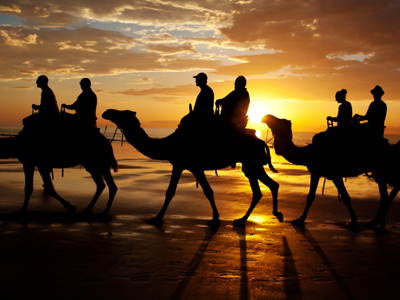
Ask the AI Tutor
Need help with Pressure 02? Ask our AI Tutor!
AI Tutor - Lucy
Connecting with Tutor...
Please wait while we establish connection

Camels have big feet so they have a large area and the pressure is small. This means they don't sink into soft sand.
Pressure 02
Pressure plays a key role in science. From deep oceans to car tyres, it explains how forces act in liquids, gases, and solids around us every day.
1 .
A box weighs 100 N. It exerts a pressure of 25 Pa on a table. What is the area of the box in contact with the table?
4 mm2
4 cm2
4 m2
4 km2
Area = force/pressure = 100/25. Remember weight is a force
2 .
A box weighs 20 N. It exerts a pressure of 2 Pa on a table. What is the area of the box in contact with the table?
10 cm2
0.1 m2
10 m2
40 m2
Area = force/pressure = 20/2 = 10 m2
3 .
A skier weighs 600 N and exerts a pressure of 2,500 Pa on the snow. What is the area of the skis?
0.12 m2
0.24 m2
1.2 m2
4.2 m2
Area = 600/2,500 = 0.24 m2
4 .
A skier weighs 600 N, lifts one ski up and exerts a pressure of 5,000 Pa on the snow. What is the area of one of the skis?
0.12 m2
0.24 m2
0.48 m2
1.2 m2
Area = 600/5,000
5 .
A student weighs 500 N, standing on two feet she exerts a pressure of 25,000 Pa on the ground. What is the area of one foot?
50 cm2
0.005 m2
0.01 m2
0.02 m2
Area = 500/25,000 = 0.02 (two feet), one foot = 0.01 m2
6 .
One box weighing 60 N is put on top of one weighing 120 N. The pressure they exert is 180 Pa. What is the area touching the ground?
0.67 m2
1 m2
2 m2
3 m2
Area = (60 + 120)/180
7 .
A 60,000N elephant can stand on one foot! The pressure it exerts is 240,000 Pa. What is the area of its foot?
0.16 m2
0.24 m2
0.25 m2
4 m2
Area = 60,000/240,000
8 .
Camels have big feet so they don't sink into soft sand because .......
they have a large area so the pressure is large
they have a large area so the pressure is small
they have a small area so the pressure is large
they have a small area so the pressure is small
Spreading their weight out over as large an area as possible means they can walk more easily over soft sand
9 .
A sharp knife cuts well because .......
it has a large area so pressure is large
it has a large area so pressure is small
it has a small area so pressure is large
it has a small area so pressure is small
A sharp blade is sharp because it has been ground to a thin edge with a very small area
10 .
Doubling the force and doubling the pressure mean .......
that area doubles
that area gets larger
that area gets smaller
that area stays the same
Area = force/pressure so if you double both force and the pressure, the area over which the force is applied will remain the same
**Unlimited Quizzes Await You! 🚀**
Hey there, quiz champ! 🌟 You've already tackled today's free questions.
Ready for more?
Ready for more?
🔓 Unlock UNLIMITED Quizzes and challenge yourself every day. But that's
not all...
not all...
🔥 As a Subscriber you can join our thrilling "Daily Streak" against other
quizzers. Try to win a coveted spot on our Hall of Fame Page.
quizzers. Try to win a coveted spot on our Hall of Fame Page.
Don't miss out! Join us now and keep the fun rolling. 🎉
**Unlimited Quizzes Await You! 🚀**
Hey there, quiz champ! 🌟 You've already tackled today's free questions. Ready for more?
🔓 Unlock UNLIMITED Quizzes and challenge yourself every day. But that's not all...
🔥 As a Subscriber you can join our thrilling "Daily Streak" against other quizzers. Try to win a coveted spot on our Hall of Fame Page.
Don't miss out! Join us now and keep the fun rolling. 🎉






